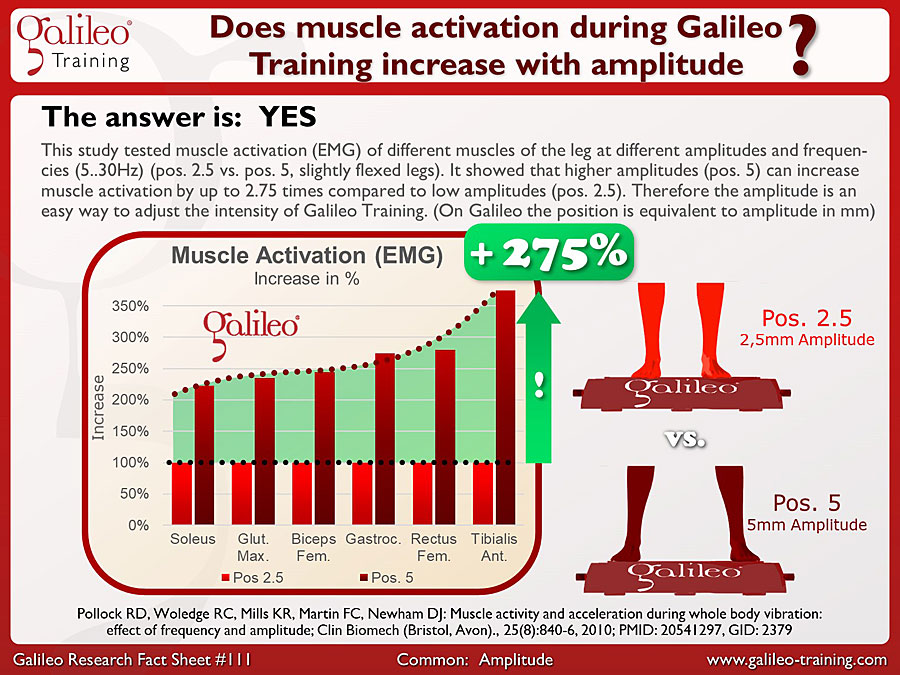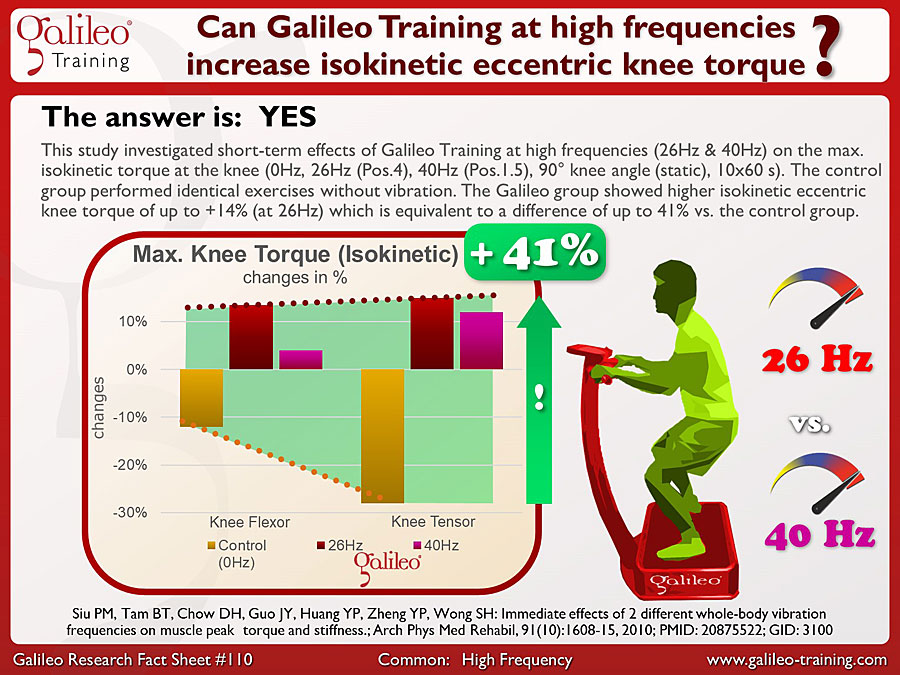This study investigates the effects of Frequency and Amplitude during Galileo Training on joint torques (10, 20, 30Hz, pos.1, pos.2, pos.3, upright standing with straight legs). Joint torque showed an significant increase with increasing frequency and amplitude of up to 250% - nevertheless joint torques stayed below those of natural walking...
This study investigated short-term effects of Galileo Training on movement efficiency (30Hz, Pos. 2, 1 min., 10% knee angle, fore-foot stance, 2x8 repetitions). The maximum ankle torque and muscle activation (EMG) was tested. After the Galileo application the torque was constant but muscle activation as well as co-contraction was decreased and hence movement efficiency was increased significantly...
This study measured the ground reaction forces during Galileo Training (forces induced into the body) (10 - 30Hz, Pos.1 - Pos.3, upright standing, locked knees). Ground reaction forces showed values below body weight (<1g) while typical peak forces during walking are in the range of 1.2 times body weight – this shows once more the high safety aspects of Galileo Training...
This Study observed short-term effects of Galileo Training on Postural Control compared to traditional balance training (25Hz, pos. 2, 2 min., almost straight leg, on forefoot). The Galileo group showed better results than the Wobble-Board group. The combination of reduction of co-contraction (-18%) and of H-Reflexes (-31%) resulted in an significant improvement of Postural Control (covered balance area -8%)...
This study investigated the effects of 12 weeks of Galileo Training on bone formation markers and bone density of the spine in physical active students (age 18-23) (15-26Hz, 5-15 min., pos.2, 3/week, 12 weeks). The control group did not receive any additional exercises. While the control group decreased bone density at the spine of by up to 1.7%, the Galileo group could increase the bone density at the spine by up to 2.7%...
This study documented the immediate effects of Galileo Training one force development, torque and range of motion (ROM) (26Hz, 5x60s, stretching of ankle). The control group performed identical exercises without Galileo Mechanostimulation. The Galileo group showed increase stretching effects (+38%) and a significant increase in torque (Platarflexion) by +18%, and an increased force development at lower ankle angles (-7°)...
This study investigated the immediate effects of Galileo Training on muscle tissue oxygenation and blood per-fusion (25Hz, 3 min., pos.2-3, 30° squats). The control group received squats (3 min, 12/min.) with additional weights matched to the VO2 values of the Galileo group. The Galileo group showed significantly higher muscle oxygenation of up to 2.4 times (+140%) starting right after the beginning and lasting longer than the exercise...
This study documented the influence of posture during Galileo Training on the transmission of vibration to the head (25Hz, Pos. 3). The transmission of vibrations to the head was measured at 5 different postures (#1: upright, #2: 20° flexed legs,… #5: 20° flexed legs + special shoulder and neck position). The results show that posture and especially flexed legs can decrease vibration transmission by up to 65%...
This study tested muscle activation (EMG) of different muscles of the leg at different amplitudes and frequen-cies (5..30Hz) (pos. 2.5 vs. pos. 5, slightly flexed legs). It showed that higher amplitudes (pos. 5) can increase muscle activation by up to 2.75 times compared to low amplitudes (pos. 2.5). Therefore the amplitude is an easy way to adjust the intensity of Galileo Training. (On Galileo the position is equivalent to amplitude in mm)...
This study investigated short-term effects of Galileo Training at high frequencies (26Hz & 40Hz) on the max. isokinetic torque at the knee (0Hz, 26Hz (Pos.4), 40Hz (Pos.1.5), 90° knee angle (static), 10x60 s). The control group performed identical exercises without vibration. The Galileo group showed higher isokinetic eccentric knee torque of up to +14% (at 26Hz) which is equivalent to a difference of up to 41% vs. the control group...









